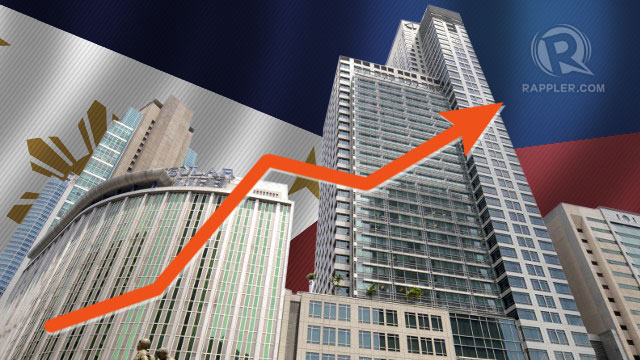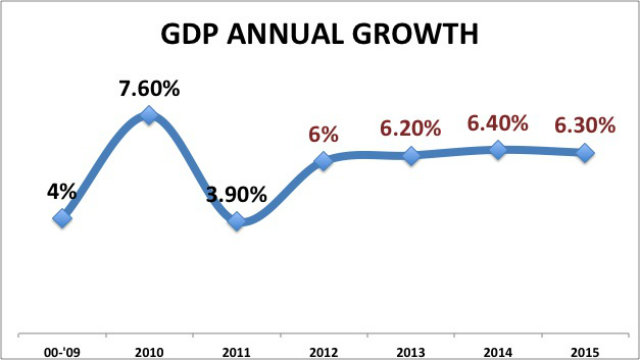SUMMARY
This is AI generated summarization, which may have errors. For context, always refer to the full article.

MANILA, Philippines – Strong domestic demand is expected to continue driving the Philippine economy and maintain its position as one of the fastest growing economies in the East Asia and the Pacific (EAP) region this year until 2015, according to a World Bank report released on Wednesday, January 16.
In its latest Global Economic Prospects, the multilateral lender said the Philippines is expected to post an average growth of 6.3% from 2013 to 2015. Excluding China, this will be the second fastest in the region, next to Indonesia, which is expected to post an average of 6.6% during the same period.
The bank also expects the Philippine economy to post a growth of 6% for 2012, the high end of the government’s official target range of 5% to 6%. The official gross domestic product (GDP) data for the fourth quarter of and whole of 2012 will be released by the National Statistical Coordination Board on January 31.
For 2013 until 2015, growth will be 6.2%, 6.4% and 6.3%, respectively, added the bank.

In the third quarter of 2012, the Philippines’ GDP grew 7.1%, largely on the back of the robust performance of the services sector.
The growth, which was the fastest in Southeast Asia and second-fastest in Asia next to China’s 7.7%, brought the average in the first 9 months of 2012 to 6.5%.
Officials were hopeful the country would achieve a GDP growth of 7% for the full year.
Regional growth
The World Bank said the Philippines’ growth as well as the growth of other ASEAN countries will help the EAP region’s GDP to expand by 5.8% in 2013, and 5.9% in 2014 and 2015.
The Washington-based lender said China is expected to post a growth of 8.4% this year, and around 8% annually from 2014 to 2015.
“Excluding China, growth in the region has been resilient to the global slowdown and accelerated to 5.6% 2012, up from 4.5% in 2011 thanks to strong domestic demand, which in major ASEAN economies (notably Indonesia, Malaysia and the Philippines) was effectively supported through countercyclical measures,” the World Bank said.
“This expansion also reflected the fact that the region grew from a low base, following last year’s flooding that cut deeply into Thailand’s output in particular. Industrial production growth picked up at 15% and export growth accelerated to 9% in the three months to November heralding economic recovery,” it added.
However, the World Bank said the openness of the region makes it vulnerable to global risks. The bank said the EAP will shed off 1% of its GDP this year if the eurozone debt crisis spills over. A 1.1% cut is also possible if the US fails to resolve its debt and fiscal issues.
The region’s growth outlook is also dependent on China’s growth. The bank said if China’s high investment rate slows down, this could impact the region and further weaken the global economy.
The report added that countries in the EAP are also vulnerable to:
- volatile capital inflows,
- related asset price bubbles,
- excessive credit growth,
- the risk of sudden capital outflows, and
- energy price spikes.
The World Bank said the region will be able to counter these vulnerabilities by deepening capital markets and implementing flexible exchange rate policies to develop effective tools for managing volatile capital flows and demand.
“The economic recovery remains fragile and uncertain, clouding the prospect for rapid improvement and a return to more robust economic growth,” said World Bank Group President Jim Yong Kim.
“Developing countries have remained remarkably resilient thus far. But we can’t wait for a return to growth in the high-income countries, so we have to continue to support developing countries in making investments in infrastructure, in health, in education. This will set the stage for the stronger growth that we know that they can achieve in the future,” Kim added.
The World Bank estimates global GDP grew 2.3% in 2012, slower compared with last June’s expectation of 2.5%. Growth is expected to barely move at 2.4% in 2013, and gradually strengthen to 3.1% in 2014 and 3.31% in 2015.
Developing-country GDP is estimated to have grown 5.1% in 2012, and is projected to expand by 5.5% in 2013, 5.7% in 2014, and 5.8% in 2015.
Growth forecasts for high-income countries have been downgraded from earlier forecasts to 1.3% for 2012 and 2013, and 2% for 2014 and 2.3% for 2015. – Rappler.com
Add a comment
How does this make you feel?
There are no comments yet. Add your comment to start the conversation.